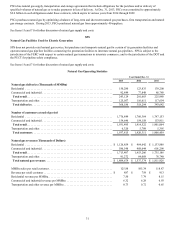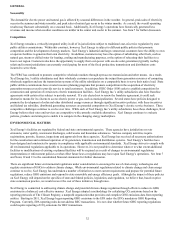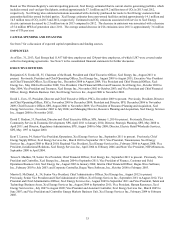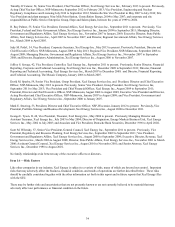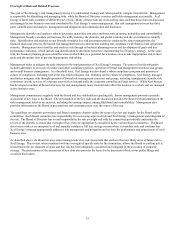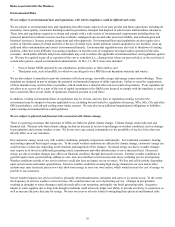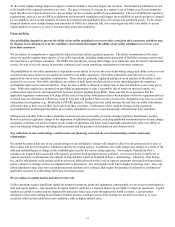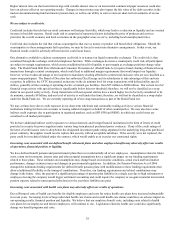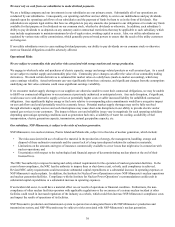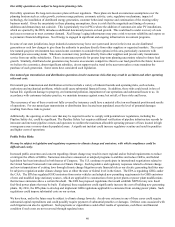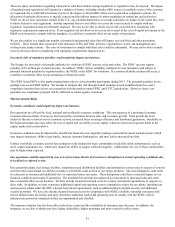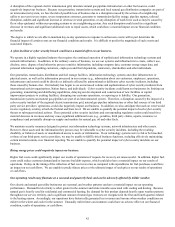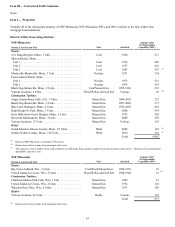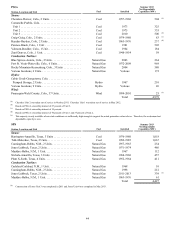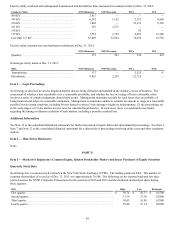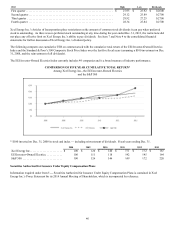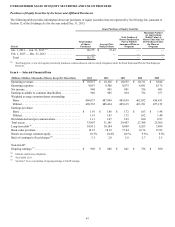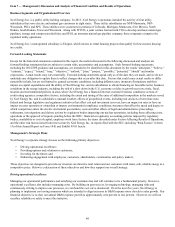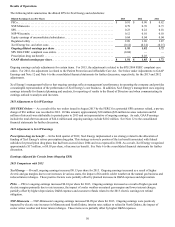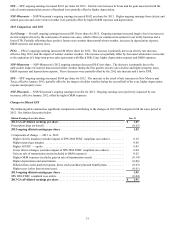Xcel Energy 2013 Annual Report Download - page 59
Download and view the complete annual report
Please find page 59 of the 2013 Xcel Energy annual report below. You can navigate through the pages in the report by either clicking on the pages listed below, or by using the keyword search tool below to find specific information within the annual report.41
There are many uncertainties regarding when and in what form climate change legislation or regulations may be enacted. The impact
of legislation and regulations will depend on a number of factors, including whether GHG sources in multiple sectors of the economy
are regulated, the overall GHG emissions cap level, the degree to which GHG offsets are recognized as compliance options, the
allocation of emission allowances to specific sources and the indirect impact of carbon regulation on natural gas and coal prices.
While we do not have operations outside of the U.S., any international treaties or accords could have an impact to the extent they lead
to future federal or state regulations. Another important factor is our ability to recover the costs incurred to comply with any
regulatory requirements that are ultimately imposed. We may not be able to timely recover all costs related to complying with
regulatory requirements imposed on us. If our regulators do not allow us to recover all or a part of the cost of capital investment or the
O&M costs incurred to comply with the mandates, it could have a material effect on our results of operations.
We are also subject to a significant number of proposed and potential rules that will impact our coal-fired and other generation
facilities. These include rules associated with emissions of SO2 and NOx, mercury, regional haze, ozone, ash management and
cooling water intake systems. The costs of investment to comply with these rules could be substantial. We may not be able to timely
recover all costs related to complying with regulatory requirements imposed on us.
Increased risks of regulatory penalties could negatively impact our business.
The Energy Act increased civil penalty authority for violation of FERC statutes, rules and orders. The FERC can now impose
penalties of $1 million per violation per day. In addition, NERC electric reliability standards are now mandatory and subject to
potential financial penalties by regional entities, the NERC or the FERC for violations. If a serious reliability incident did occur, it
could have a material effect on our operations or financial results.
The FERC issued NOVs of its market manipulation rules to several market participants during 2013. The potential penalties in one
pending case exceed $400 million. We attempt to mitigate this risk through formal training on such prohibited practices and a
compliance function that reviews our interaction with the markets under FERC and CFTC jurisdictions. However, there is no
guarantee our compliance program will be sufficient to ensure against violations.
Macroeconomic Risks
Economic conditions could negatively impact our business.
Our operations are affected by local, national and worldwide economic conditions. The consequences of a prolonged economic
recession and uncertainty of recovery has lowered the correlation between sales and economic growth. Sales growth has been
relatively flat due to lower level of economic activity, increased focus on energy efficiency and distributed generation. Instability in
the financial markets also may affect the cost of capital and our ability to raise capital, which are discussed in greater detail in the
capital market risk section above.
Economic conditions may be impacted by insufficient financial sector liquidity leading to potential increased unemployment, which
may impact customers’ ability to pay timely, increase customer bankruptcies, and may lead to increased bad debt.
Further, worldwide economic activity has an impact on the demand for basic commodities needed for utility infrastructure, such as
steel, copper, aluminum, etc., which may impact our ability to acquire sufficient supplies. Additionally, the cost of those commodities
may be higher than expected.
Our operations could be impacted by war, acts of terrorism, threats of terrorism or disruptions in normal operating conditions due
to localized or regional events.
Our generation plants, fuel storage facilities, transmission and distribution facilities and information systems may be targets of terrorist
activities that could disrupt our ability to produce or distribute some portion of our energy products. Any such disruption could result
in a decrease in revenues and additional costs to repair and insure our assets. These disruptions could have a material impact on our
financial condition and results of operations. The potential for terrorism has subjected our operations to increased risks and could
have a material effect on our business. We have already incurred increased costs for security and capital expenditures in response to
these risks. In addition, we may experience additional capital and operating costs to implement security for our plants, including our
nuclear power plants under the NRC’s design basis threat requirements, such as additional physical plant security and additional
security personnel. We have also already incurred increased costs for compliance with NERC reliability standards associated with
critical infrastructure protection, and may experience additional capital and operating costs to comply with the NERC critical
infrastructure protection standards as they are implemented and clarified.
The insurance industry has also been affected by these events and the availability of insurance may decrease. In addition, the
insurance we are able to obtain may have higher deductibles, higher premiums and more restrictive policy terms.


